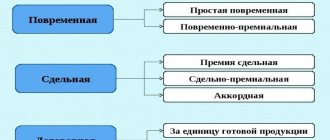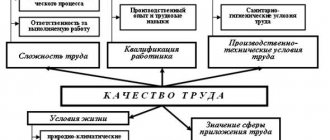Based on a time sheet
Despite the fact that with any form of remuneration, the employer is obliged to keep records of the working time actually worked by each employee (Article 91 of the Labor Code of the Russian Federation), it is the work time sheet under the time-based wage system that is the main document on the basis of which wages are calculated .
The employer develops the form of the working time sheet independently and consolidates it in its accounting policy for accounting purposes. Form No. T-13 (approved by Resolution of the State Statistics Committee dated January 5, 2004 No. 1) can be used as a guide.
Calculation of wages for piecework and bonus calculations
Special procedure for calculating salaries.
Wages when using the piecework-bonus system are calculated based on several indicators at once, namely:
- Payment for fully completed work at the established rate;
- Payment for overtime and additional shifts, work on days off, etc.;
- Bonuses for a high level of work performance, if any;
- Bonuses for significantly exceeding the standards of manufactured products or work performed;
- Bonuses for completing a task ahead of schedule (most often used in construction and similar areas);
- Additional payments for special working conditions (dangerous and/or hazardous industries).
For a full month - salary
With a time-based wage system, wages are calculated based on the salary. Salary is a fixed amount of remuneration for an employee for the performance of labor (official) duties of a certain complexity for a calendar month, excluding compensation, incentives and social payments (Article 129 of the Labor Code of the Russian Federation). The employer can set not a monthly salary, but an hourly rate, which is especially convenient for employees with a flexible schedule or part-time workers. We discussed the specifics of calculating earnings for hourly wages in a separate consultation.
Contents of payments: salary and bonus plus possible compensation and incentive payments
An employee’s salary under the salary-bonus system consists of several parts. The employer must pay:
- The salary, which according to Art. 129 of the Labor Code is remuneration for a month of performance of official duties of established complexity in a fixed amount. The salary amount is set by the employer. The grounds for differentiating the amount of an employee’s salary under Art. 132 TC are:
- worker qualifications, which means professional training, employee experience and other requirements; for a number of positions, the requirements are listed in the Qualification Directory, approved. Resolution of the Ministry of Labor dated August 21, 1998 No. 37;
- complexity of the work;
- quality, quantity of labor expended.
It is impossible to evaluate the last 2 criteria in isolation from qualifications. The complexity of the assigned work, the quantity and quality of the work performed are determined by the level of professional training of the employee.
- A bonus in the amount determined by the employer if the employee fulfills the bonus conditions. If the worker has not fulfilled the necessary conditions, then it is not necessary to pay a bonus.
- Compensation payments that are part of the salary. In accordance with the List of types of compensation payments, approved. by order of the Ministry of Health and Social Development dated December 29, 2007 No. 822, these include payments:
- for hard work or harmful and dangerous working conditions;
- work in the Far North and other areas characterized by special climatic conditions;
- work with deviations from normal conditions: combined work, overtime, night shifts, etc.
- working with state secrets or codes.
It is important not to confuse compensation payments as part of remuneration with payments outside of it. These are compensations in cases provided for in Art. 165 TK:
- when sent on a business trip;
- combining work and study;
- termination of work without the employee’s fault, etc.
At its discretion, the employer may provide for other incentive payments as mandatory.
Time-bonus system
The time-based bonus system of remuneration provides not only accrual for time actually worked, but also additional remuneration (bonus) for achieving certain results (for example, efficiency and quality of work). The procedure for calculating and accruing bonuses is provided for by the regulations on remuneration, regulations on bonuses, an employment contract or other document.
It is possible to combine piecework and time-based wages, when wages are calculated not only for the time actually worked, but also for specific labor results, recorded, for example, in a piecework work order.
Litigation regarding time-based bonus wages
Legal disputes that arise when applying a time-based bonus system of remuneration are disputes related to the non-awarding or deprivation of a bonus to an employee, as well as the payment of bonuses in a smaller amount than what the employee expected.
Non-accrual of a bonus may occur if the conditions under which its accrual in accordance with the normative act on bonuses is generally possible are not met. For example, the organization’s work during the bonus period was completed with a negative financial result. In such cases, the entire workforce may be left without a bonus.
Deprivation of a bonus (reduction in its size) usually concerns certain individuals and is associated with reasons listed in a separate section of the regulatory document on bonuses. Such a reason may be the employee committing a disciplinary offense or dismissal during the bonus period. One of the grounds for deprivation of a bonus may be a decision made by the manager. Such a decision becomes the only basis for non-payment of bonuses if the regulatory act on bonuses does not contain an established procedure for de-bonding at all. An option for the head of an organization to participate in the reduction of bonuses may be to grant him the right to determine the share by which the amount of bonuses will be reduced on the grounds approved in the regulatory document on bonuses.
The key to victory for an employer in disputes with employees regarding non-payment of bonuses will be:
- careful study of all conditions for accrual or non-accrual (deprivation) of bonuses;
- consolidation of these conditions in an internal regulatory act;
- familiarization of all employees subject to bonuses with this act against signature;
- strict compliance with all rules regarding the accrual (non-accrual) of bonuses when distributing bonuses;
- mandatory execution of written orders of the manager in situations where he has the right to make decisions on the deprivation (reduction) of a bonus or establishing the amount of this reduction;
- familiarization of the employee, who is affected by the manager’s order to deprive (reduce) the bonus, with this document against signature.
Fulfillment of all conditions under which the bonus must be accrued obliges the employer to pay it (decision of the St. Petersburg City Court dated June 22, 2011 No. 33-9390/2011). At the same time, if it follows from the text of the regulatory act on bonuses that the decision on whether to award employees bonuses based on the results of work for the period is made by the manager, non-payment of the bonus will be lawful (decision of the St. Petersburg City Court dated April 27, 2011 No. 33-6236 /2011).
Deprivation (reduction) of a premium on grounds not provided for in the regulatory document is generally unacceptable. But even for the reasons specified in the normative act, it may turn out to be illegal if:
- documents were drawn up in violation of the order to justify this reason (for example, for a disciplinary offense);
- the algorithm for reducing the premium amount was incorrectly applied;
- there is no administrative document from the manager on the deprivation of bonuses or on establishing the amount of reduction in the amount of bonuses in a situation where his decision on the relevant issue is mandatory;
- there is no evidence that the employee is familiar with this administrative document (order) of the manager.
The presence of all the necessary documents and their correct execution guarantees the employer victory in legal disputes (ruling of the Vologda Regional Court dated April 26, 2013 in case No. 33-1815/2013, ruling of the Omsk Regional Court dated December 24, 2015 in case No. 33-9834/2015) .
Read more about the preparation of documents for disciplinary offenses in the article “Disciplinary offense under the Labor Code of the Russian Federation - concept and signs”.
Premium remuneration systems; purpose, essence and types of awards
There are two forms of remuneration. Payment is established either depending on the time during which the enterprise used labor, or in accordance with the volume of work performed. In the first case, payment is called time-based, in the second case - piece-rate.
Premium wages are an additional payment system, which must be used in combination with any basic one - time-based or piece-rate system. According to their purpose, bonuses are divided into two groups: bonuses for the main results of economic activity and bonuses for improving certain aspects of production activity (special). Bonuses, as a rule, are targeted in nature and serve as a means of stimulating employee motivation to achieve certain goals that are significant for the organization.
Time-bonus - a wage system in which a premium in a certain percentage of the tariff rate or other measure is added to the amount of earnings at the tariff. The primary documents for recording the labor of employees with time-based payment are time sheets. The time-bonus wage system is used to improve qualitative or quantitative indicators (accident-free operation, improved product quality).
With a piece-rate bonus system, in addition to earnings at direct piece rates, a bonus is paid for fulfilling and exceeding the plan according to pre-established qualitative or quantitative indicators.
This is interesting: Office of the President for Foreign Policy
Bonuses are an integral part of the employee motivation scheme, designed to stimulate them to perform better and more efficiently. A bonus is an additional payment of a stimulating or incentive nature to the employee’s basic earnings.
Thus, bonuses can be of two types: 1. Incentive bonuses, which are provided for by the remuneration system.
According to Article 135 of the Labor Code, the employer has the right to establish various systems of bonuses, incentive payments and allowances, taking into account the opinion of the representative body of employees. These systems can also be established by collective agreement.
At the same time, the bonus remuneration system adopted by the organization must provide for the payment of bonuses to a certain circle of people based on pre-established specific indicators and bonus conditions.
2. Bonuses (encouragement) for distinguished employees outside of remuneration systems. According to Article 191 of the Labor Code, an employer can reward employees who conscientiously perform their job duties. Employees may be paid one-time bonuses: for increasing labor productivity; for many years of conscientious work; for improving product quality; for innovation in work; for flawless performance of job duties; for other achievements in work provided for by the Internal Labor Regulations and the collective agreement.
When paying one-time bonuses, the circle of bonuses is not determined in advance.
The amount of the bonus to each employee for a certain period is established in the order of the head of the organization. This takes into account: the employee’s personal contribution to the organization’s activities; the result of the work of the department in which the employee performs his job duties; the result of the organization's activities.
Salary composition and documents defining it
According to Art. 129 of the Labor Code of the Russian Federation, salary can be a value made up of 3 parts:
- the actual salary or payment for the work directly performed;
- compensation payments that take into account the special conditions in which work is carried out;
- additional incentive payments, the purpose of which is additional encouragement for work results and, accordingly, increasing interest in these results.
The first 2 parts are mandatory for establishment and are largely regulated by the Labor Code of the Russian Federation:
- types of remuneration have been determined (Article 129) and data sources for tariffication of work according to their complexity (Articles 143, 144);
- the minimum wage is limited (Articles 130, 133 and 133.1) and the share of payment in kind (Article 131);
- for state institutions, salary indexation is mandatory (Article 134) and the maximum amount of payments to its managers is limited by dependence on the average salary for the institution (Article 145);
- the mandatory requirement for increased wages, carried out under special conditions, is stipulated (Articles 146–149, 152–154).
At the same time, the introduction of an incentive part of the salary is not mandatory. Therefore, each employer independently resolves issues (Articles 129, 135 of the Labor Code of the Russian Federation):
- about the presence of this part as part of the salary;
- on the rules for calculating incentive payments.
The employer approves the adopted wage structure and the developed incentive rules in internal regulatory documents. Such documents may be:
- regulations on the remuneration system, which in a separate section includes incentive rules;
- a collective agreement describing both the remuneration system and incentive rules;
- separate documents (provisions) devoted to: one - the remuneration system,
- the other is the incentive system used;
The content of internal regulations independently developed by the employer on issues of labor law is mandatory:
- consistent with representatives of the labor collective (Article 135 of the Labor Code of the Russian Federation);
- is brought to the attention of each employee against signature as an integral part of the terms of the employment agreement (Article 57 of the Labor Code of the Russian Federation).
ConsultantPlus experts explained what types, forms and systems of remuneration there are, as well as the procedure for calculating wages for various forms of remuneration. If you do not have access to the K+ system, get a trial online access for free.
For more information about the documents establishing the rules for bonuses, read the article “The procedure for paying bonuses under the Labor Code of the Russian Federation.”
Answer
The employer sets the remuneration system independently (Part 2 of Article 135 of the Labor Code of the Russian Federation). At the same time, changing the remuneration system will require changes to employment contracts with employees. An organization can change employment contracts unilaterally only if there are organizational or technological changes (Article 74 of the Labor Code of the Russian Federation).
So, in order to introduce a time-bonus wage system, you will need:
— make changes to the wage regulations or develop a new regulation. Develop Regulations on bonuses;
— make changes to employment contracts with employees (conclude additional agreements to employment contracts);
- make changes to the staffing table.
Visually, the employer’s action algorithm will look like this:
In the Regulations on remuneration it will be necessary to indicate that the organization is introducing a time-based bonus system of remuneration. All employees will need to be familiarized with this provision and signed.
The introduction of a new remuneration system will change the terms of remuneration specified in employment contracts. In this regard, it will be necessary to conclude an additional agreement to the employment contract, which will indicate the new salary amount, as well as the possibility of paying a bonus. Please note that it is not necessary to directly indicate in the text of the employment contract the size, conditions and procedure for paying bonuses. You can make a link to the Regulations on Bonuses. All employees must be familiarized with this provision and signed.
Let us note once again that all changes to the terms of the employment contract are possible only by agreement of the parties (Article 72 of the Labor Code of the Russian Federation). An employer can unilaterally change the terms of an employment contract only if there are organizational or technological changes and in compliance with the procedure established by Article 74 of the Labor Code of the Russian Federation.
Thus, employees will need to be notified at least two months before the changes are introduced. If the employee refuses to continue under the changed conditions, the employment contract is terminated on the basis of clause 7, part 1, article 77 of the Labor Code of the Russian Federation.
This is interesting: Ooo can be created
The staffing table will also need to indicate the new salary level, as well as the amount of bonuses.
Details in the materials of the Personnel System:
1. Situation: How to make changes to an employment contract if they are caused by a change in organizational or technological working conditions in the organization
Ivan Shklovets
, Deputy Head of the Federal Service for Labor and Employment
Changes to the employment contract for reasons related to changes in organizational or technological working conditions include, for example:
- changes in equipment and production technology, for example, the introduction of new equipment, technical regulations, which led to a reduction in the employee’s workload, as well as changes in the rules for operating equipment, improvement of workplaces (appeal ruling of the Supreme Court of the Komi Republic dated December 2, 2013 No. 33-6124 /2013);
- structural reorganization of production, for example, the exclusion of any stage of the production process, the introduction of new labor regimes, changes in the remuneration system in the organization as a whole, labor standardization systems, redistribution of tasks and areas of responsibility between structural divisions;
- other changes in organizational or technological working conditions that led to a reduction in the employee’s workload.
At the same time, it is prohibited to change the employee’s job function.
This is stated in Part 1 of Article 74 of the Labor Code of the Russian Federation.
The organization is obliged to notify the employee against signature about upcoming changes related to changes in organizational or technological working conditions, as well as about the reasons that caused the need for such changes. This must be done no later than two months before the introduction of such changes. This is stated in Part 2 of Article 74 of the Labor Code of the Russian Federation. If the employee agrees with the upcoming changes, draw up an additional agreement to the employment contract (Article 72 of the Labor Code of the Russian Federation).
If an employee does not agree to work under the new conditions, then the organization is obliged to offer him another job, including a lower-ranking one with lower pay, if the organization has suitable vacancies. An employee should only be offered vacancies that are available to the employer in the given area. Job vacancies in other locations should be offered only if this is provided for in a collective agreement, labor agreement, or other agreements. This procedure is enshrined in Part 3 of Article 74 of the Labor Code of the Russian Federation.
If the employee refuses to work under the new conditions or there are no suitable vacancies in the organization, then the employment contract can be terminated:
- to reduce staff on the basis of clause 2 of part 1 of Article 81 of the Labor Code of the Russian Federation with the payment of all compensation - if we are talking about changing the working regime, namely the introduction of a partial regime (Part 6 of Article 74 of the Labor Code of the Russian Federation);
- in connection with the refusal to continue work in new conditions on the basis of clause 7 of part 1 of article 77 of the Labor Code of the Russian Federation, also with the payment of compensation - in all other cases (part 3 of article 178 of the Labor Code of the Russian Federation).
2. Situation: Is it necessary to include grades, allowances and bonuses in the staffing table?
Nina Kovyazina
, Deputy Director of the Department of Medical Education and Personnel Policy in Healthcare of the Russian Ministry of Health
Staffing form No. T-3 was approved by Decree of the State Statistics Committee of Russia dated January 5, 2004 No. 1. This form contains the columns “rank” and “addition”. Therefore, if a rank is provided for a particular position, as well as the payment of bonuses or allowances, this information must be reflected in the staffing table.
In column 3 of this form, reflect the rank of position (if any). In column 5 - salary in accordance with the remuneration system adopted in the organization. In columns 6–8 “Bonuses”, indicate incentive and compensation payments that are established by current legislation, for example, northern bonuses, bonuses for an academic degree, etc., as well as bonuses, bonuses, additional payments introduced at the discretion of the organization, for example, related to the regime or working conditions. In this case, the indicators in columns 5–8 can be expressed not only in monetary terms - in rubles, but also in other units of measurement, for example, in percentages, coefficients, etc.
This is interesting: Job description of the deputy director for educational work
Such rules were established by Resolution of the State Statistics Committee of Russia dated January 5, 2004 No. 1.
However, from January 1, 2013, in connection with the adoption of the Law of December 6, 2011 No. 402-FZ, the use of unified forms is not mandatory for most organizations. The exception is public sector organizations. They must still use unified forms in their work without fail.
All other organizations, when drawing up organizational and administrative documents, have the right to continue to use both unified forms and to develop them independently.
Such conclusions follow from the totality of the provisions of Articles 7, 9 of the Law of December 6, 2011 No. 402-FZ. A similar opinion was expressed by employees of the Russian Ministry of Finance in a letter dated December 4, 2012 No. PZ-10/2012.
Thus, if an employer uses an independently developed form of staffing, then he can indicate grades, allowances and bonuses or not indicate them at all if they are not provided for in the organization.
With respect and wishes for comfortable work, Elena Karsetskaya,
Reflection of bonuses in expenses
The company always records all its expenses, including in order to correctly pay income taxes. If the employer decides to issue a bonus, this also applies to the company's expenses, but not in all cases:
- If the bonus is related to the employee’s work achievements (fulfillment, exceeding the plan, conscientious work, active participation in new projects, etc.), then such costs can be recognized as expenses. Therefore, the payment of the premium in this case, as well as the payment of insurance premiums from it, is necessarily included in the employer’s expenses.
- If the payment is not directly related to labor merit (an anniversary, another important date), then it cannot be taken into account in the company’s expenses. The corresponding justification is given in the Letter of the Ministry of Finance of the Russian Federation.
The best option from the point of view of preventing claims from inspection bodies is a clear organization of the process of paying bonuses. To do this, you can draw up appropriate regulations on bonuses, where you can specify the grounds, amounts and procedure for their payment. The same points can be reflected in an individual and/or collective employment contract.
Time-based salary
Typically, this method of calculation is used in direct sales, various trade organizations, and some manufacturing enterprises. With a mixed form of payment, the employee is more interested in the final result. Typically, a fixed percentage due to the employee is established on the volume of goods sold or products produced.
Namely, in those types of activities where exceeding the plan is not required. The time-based wage system is the most common and effective. Currently used in most developed countries of the world.
Reflection of bonuses in the 2-NDFL certificate and pay slip
All employee income (including those paid irregularly) are reflected in the documents:
The bonus is indicated in the month when the actual payment was made (and not when the corresponding decision was made). The following codes are used for marking.
| code | meaning |
| 2002 | payment accrued in connection with professional achievements |
| 4800 | payment accrued in connection with other (non-labor) achievements |
| 501 | gift from the company |
| 503 | providing financial assistance |
| 504 | providing assistance in purchasing medications |
The date of receipt of bonus income is the date of salary, i.e. the last day of the corresponding month. This is exactly how the premium should be reflected in the 2-NDFL certificate.









